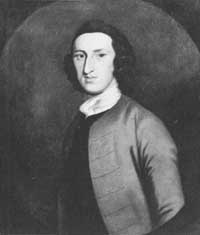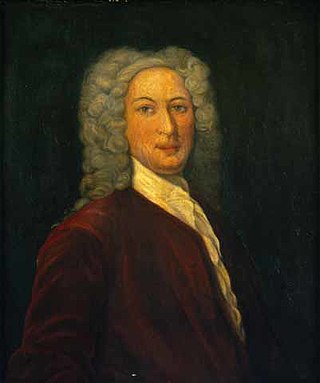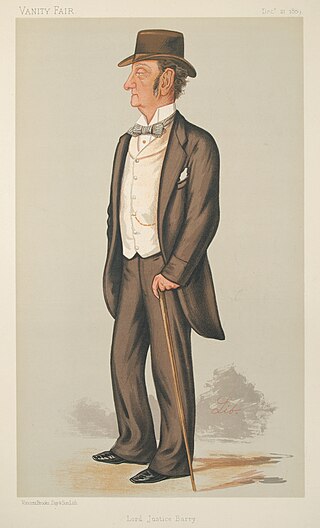Related Research Articles
Robert Livingston was the third and final Lord of Livingston Manor and a member of the assembly for the manor from 1737 to 1790. He was also U.S. Secretary of Foreign Affairs from 1781–1783.

William Livingston was an American politician and lawyer who served as the first governor of New Jersey (1776–1790) during the American Revolutionary War. As a New Jersey representative in the Continental Congress, he signed the Continental Association and the United States Constitution. He is considered one of the Founding Fathers of the United States and a Founding Father of New Jersey.

Philip Livingston was an American merchant, politician and slave trader from New York City. He represented New York at the October 1774 First Continental Congress, where he favored imposing economic sanctions upon Great Britain as a way of pressuring the British Parliament to repeal the Intolerable Acts. Livingston was also a delegate to the Second Continental Congress from 1775 to 1778, and signed the Declaration of Independence, thus becoming one of the Founding Fathers of the United States.

Philip Livingston was an American merchant, slave trader and politician in colonial New York. The son of Robert Livingston the Elder and elder brother of Robert of Clermont, Philip was the second lord of Livingston Manor.

Arnold Böcklin was a Swiss Symbolist painter.
David Fitz-James de Barry, 18th Baron Barry, 5th Viscount Buttevant (1550–1617), sided initially with fitz Maurice, the rebel, in the 1st Desmond rebellion but changed sides and fought against the rebels. He also fought for the crown in the Nine Years' War.

Henry Walter Livingston was a United States Representative from the state of New York.
Robert Le Roy Livingston was a United States representative from New York.

William Bayard Cutting, a member of New York's merchant aristocracy, was an attorney, financier, real estate developer, sugar beet refiner and philanthropist. Cutting and his brother Fulton started the sugar beet industry in the United States in 1888. He was a builder of railroads, operated the ferries of New York City, and developed part of the south Brooklyn waterfront, Red Hook.

The Livingston family of New York is a prominent family that migrated from Scotland to the Dutch Republic, and then to the Province of New York in the 17th century. Descended from the 4th Lord Livingston, its members included signers of the United States Declaration of Independence and the United States Constitution. Several members were Lords of Livingston Manor and Clermont Manor, located along the Hudson River in 18th-century eastern New York.
Charles Ludlow Livingston was an American politician from New York.
James Hooker was an American lawyer and politician from New York.

Henry Brockholst Livingston was an American Revolutionary War officer, a justice of the New York Court of Appeals and eventually an associate justice of the Supreme Court of the United States.

Charles Robert Barry QC, PC was an Irish politician and lawyer who rose to become a Lord Justice of Appeal for Ireland.
Admiral Andrew Kennedy Bickford CMG was a Royal Navy officer who went on to be Commander-in-Chief, Pacific Station.
Major Anthony Brockholls was an English born Commander-in-Chief (1677–78) and then acting Governor (1681–82) of New York.
Edwin Brockholst Livingston was an amateur historian. His lifetime work was the research and publication of the genealogy of the Scottish Livingston family of Callendar, and the offshoots of the family that sought their fortune in colonial America. These included, Robert “the Founder”, Governor William Livingston of New Jersey and his brother Philip who was a signer of the Declaration of Independence, Judge Robert R. Livingston of Clermont and his son, plus Edward Livingston, the friend and adviser of Andrew Jackson.
Thomas Edward Davis or Davies was a prolific real estate developer who built residential properties in New York between 1830 and 1860.
Robert Fulton Cutting, was an American financier and philanthropist known as "the first citizen of New York." Cutting and his brother William started the sugar beet industry in the United States in 1888.

Jasper Hall Livingstone was an American horse owner, gentleman rider and sportsman. He was chargé d'affaires under Ambassador Washington Irving at Madrid and later the Master of the Pau Hounds for 11 non-consecutive winter seasons between 1847 and 1873. He was an innovator of drag hunting and mocked in the development of this "fictitious" sport, while some considered it ideal for young riders or "the impatient and brave who hunted to ride rather than rode to hunt".
References
- ↑ Magistracy - more resignations and dismissals; Cork Examiner - Friday 2 June 1843 – page 4.
- ↑ Exchange of letters between Maurice Power and Francis William Brady, Secretary to the Lord Chancellor, Dublin; Cork Examiner page 2- Monday 12 October 1846 –
- ↑ "THE IRISH GOVERNMENT AND THE "WORLD" NEWSPAPER". Parliamentary Debates (Hansard) . Hanard. 19 February 1852. Retrieved 2 February 2014.
- ↑ Cork Examiner page 2- Monday 4 March 1867
- ↑ Political history of the late Mr Sadlier; Norfolk Chronicle page 4 - Saturday 8 March 1856;
- ↑ "Dr Power, Governor of St Lucia". The Cork Examiner. 28 November 1855.
- 1 2 3 Timothy Cadogan & Jeremiah Falvey (2006). A Biographical Dictionary of Cork. Dublin: Four Court Press. p. 285.
- ↑ "Mr Jasper Hall Livingstone". Ryde Social Heritage Group. Retrieved 20 July 2014.
- ↑ "THE SWISS PROTESTANT CEMETERY OF FLORENCE" . Retrieved 20 July 2014.
- ↑ "An Eccentric New-Yorker in Florence" (PDF). New York Times. 19 July 1878. Retrieved 20 July 2014.
- ↑ See items 24, 25 & 26. "Descendents of Katherine Seaman" . Retrieved 27 January 2014.
- ↑ Death of Mr B Power, Queenstown; Freeman's Journal page 4- Friday 12 June 1891
- ↑ "Soldier Details". Brockholst L Power. National Park Service. Retrieved 27 January 2014.
- ↑ "John Livingston Power". National Archives. Retrieved 27 January 2014.
- ↑ "Births". Cork Examiner. 24 July 1850. Retrieved 20 July 2014.
- ↑ Livingston, Edwin Brockholst (1910). The Livingstons of Livingston manor;being the history of that branch of the Scottish house of Callendar which settled in the English province of New York during the reign of Charles the Second; and also including an account of Robert Livingston of Albany, "The nephew," a settler in the same province and his principal descendants. New York. Retrieved 9 December 2017.
{{cite book}}: CS1 maint: location missing publisher (link) - ↑ "Legal Notices". No. Page 2. New York Daily Tribune. 20 January 1860.
- ↑ De Burgh, Hussey (1878). The Landowners of Ireland. HODGES, FOSTER AND FIGGIS.